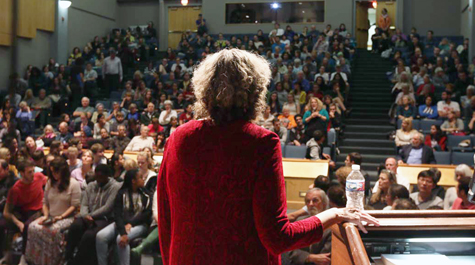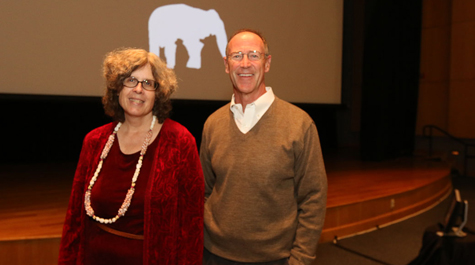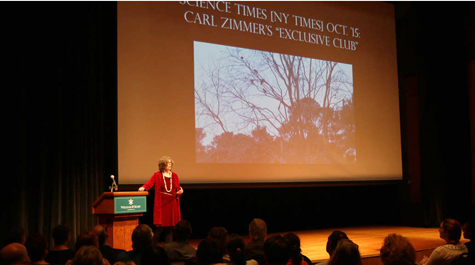King expands our knowledge of animal emotions
A small male Brazilian Marmoset, clearly agitated and distressed, scrambles madly down a tree and onto the jungle floor to tend to his mate of three years -- the mother of their eight offspring -- who has fallen and is mortally wounded. In a valiant but vain effort to protect her, he covers her body with his own.
A primatologist who witnessed the event told the British Broadcast Corporation that she was “left astounded” by such behavior.
In delivering the William & Mary Tack Faculty Lecture, endowed by Carl and Martha Tack, both ’78, and entitled “Wild Grief/Untamed Love,” Chancellor Professor of Anthropology Barbara J. King seemed astounded that her fellow scientist was astounded.
“That word ‘astounded’ really struck me,” King told an overflow audience of more than 800 on Oct. 28 at Sadler Center’s Commonwealth Auditorium. “I started thinking about it. Should we really feel amazed and astounded when we see that other animals express care, express affection, express mourning?”
{{youtube:medium|MQ4EauxFUvU, No animal holocaust}}
She quoted from a recent New York Times article in which the author claimed that there was an “exclusive club” of animals that paid attention to their dead – elephants, chimpanzees, dolphins, crows and relatives of crows known as scrub jays.
“I’m here to tell you that I don’t think the club is as exclusive as a lot of a scientists think,” she argued, adding that she has joined with a group of people who have been working on animal emotion. They have the data to suggest that grief “is a much more widespread process.”
King gave some examples:
A Kenyan elephant named Eleanor, the matriarch of her family, appears one day with a swollen trunk, bruised leg and is swaying. Grace, the matriarch of another family, approaches and tries to prop up Eleanor with her trunk. She fails and Eleanor dies. During the next couple of weeks there is a literal parade of female and juvenile elephants from five different families who come and stand at her body. Some step over it and move on, but some stay on, rocking back and forth.
A baboon named Sylvia, and her daughter, Sierra, have a deeper relationship than usual, choosing to stay in each other’s company beyond the norm. But when Sierra is killed by a lion, Sylvia changes completely. She withdraws socially – despite her high-ranking status in that community -- doesn’t eat, loses interest in grooming.
The scientist observing this concludes that she is witnessing that baboon in mourning.
A bottle-nosed dolphin mother, aware that something is mortally wrong with her calf, spends two days using her snout and pectoral fins to keep her baby afloat on the water.
A scientist who has studied bottle nosed dolphins for years describes the scene as grief.
On the other hand, there are situations like the one where an infant gelada in the Ethiopian highland dies and the mother clutches it tightly to her body for days, even weeks. However, according to Peter Fashing ’91, a primatologist and former student of King’s, she continues to go about her daily business, eating, resting, grooming – even mating.
Clearly, King said, this represents the absence of any physical expression of grief.
“This is a very new field for anthropology, for biology, to be thinking about animals response to death,” said King, the author of How Animals Grieve. “It underscores the point that we really want to look at both the presence and the absence of these emotions to understand where they occur and where they don’t.”
That is easier said than done. King played a portion of a video that shows a baby elephant frolicking in the surf, heralded as the first time it had ever seen the ocean. The reality was that, beyond the camera’s lens, the elephant’s “handler” was prodding the animal with a sharp-edged stick to discipline it and keep it returning to the water, all to get money from tourists. What appeared to be a joyful romp was something far more sinister.
{{youtube:medium|HISFDFMTv_Y, Beyond viral videos}}
“It’s very important to be cautious, conservative,” King said. “We don’t want to jump to conclusions based on a few minutes of observation or a video. There are all kinds of videos that claim to show not only animal grief but death rituals . . . We really have to look more deeply than just a picture in the media or a video that’s very intriguing. We need to look very carefully at the animals we’re talking about."
King lampooned the traditional definition of anthropomorphism as the “projection of human qualities onto animal lives” as the “inappropriate projection of human qualities onto animal lives.
Anthropomorphism is hardly new. It dates back to Charles Darwin and his book The Expression of the Emotions in Man and Animals. Darwin used expressions like “benevolent,” and “pouting” to describe the looks on animals’ faces, but he didn’t just consult books or drawings. He went to observe them himself, and was especially taken by an orangutan named Jenny, who was removed from the wild and, briefly until her death, housed at the London zoo.
But 19th century interest in animal emotion was soon overtaken by hard-core skeptics who were uncomfortable using the words “thinking” and “feeling” in regard to animals. There’s a renaissance now in studying animal thinking and feeling, seeing animals in a new light and what King called the “new science of animal emotion.”
{{youtube:medium|KfYdOhLQpt4, Darwin and the "A" word}}
Early in King’s career as an anthropologist, she studied monkeys in Kenya, African apes at the National Zoological Park in Washington, D.C. and at Georgia State University and was convinced that they were intelligent, thinking, problem-solving creatures.
Later, after she became interested in other animals, she formulated a definition of animal grief as it related to the reaction of a companion animal. That necessitated knowing how the animal behaved when its companion – not necessarily mate -- was alive, qualitative data that surpassed anecdote.
She relied, she said, on peer-reviewed scientific literature, interviews with wildlife researchers, sanctuary and zoo staff and “animal people,” which she defined as those who live with animals, study their animals and think about what they do.
She concluded that if an animal becomes socially withdrawn after the death of a companion or mate, doesn’t eat or sleep, assumes a different body posture than usual, a different affect or different facial expressions, he or she may well be grieving.
“That requires a period of time knowing the animal,” she explained.
Love? There’s a theory she was taught years ago that animals spend time together primarily to enhance their reproductive possibilities. It’s all very sterile and technical.
She doesn’t necessarily buy it, though she admits “it’s more fraught for me.”
“Is it outlandish to write about animal love?” she said, quoting from her book. “How could we ever recognize what love is to an ape, much less to a goat? Can we define human love? Don’t we sometimes have trouble differentiating between friendship and love?”
King looks at animals that choose to spend time together beyond what might be expected and describes the quality and intensity of their relationship with each other.
That’s something we should be hearing more about in the future. King is leaving the university at the end of the semester to pursue writing fulltime on animal issues for various publications and outlets and to continue speaking out about animal welfare and assisting humans in gaining a better, more nuanced, understanding of it.


















